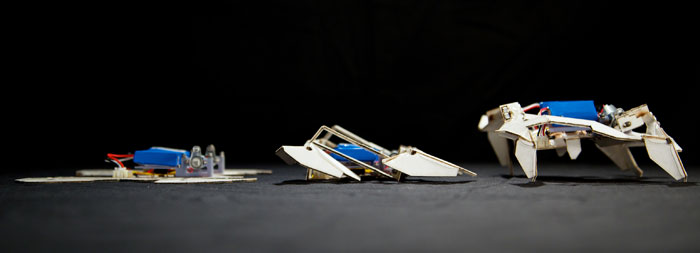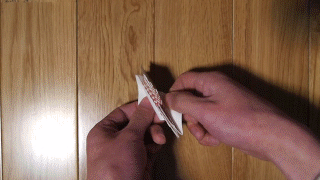For Real-Life Transformers, Mix Paper, Batteries and Origami

Image credits: Courtesy of Seth Kroll, Wyss Institute
(Inside Science) -- Disappointed that your Transformers action figures can't transform themselves? Researchers have created real-life transformer robots that can fold themselves from sheets into walking pieces of motorized origami.
These new inventions could one day lead to sophisticated machines that can be shipped in flat boxes like IKEA-style furniture that assembles itself at home, or unfold in outer space for exploration, or deployed into confined spaces such as collapsed buildings for search-and-rescue operations. Origami-based engineering could also lead to lightweight, ultra-tough materials that can alter their mechanical properties on demand, scientists added.
Roboticist Sam Felton at Harvard University and his colleagues began investigating origami, the Japanese art of folding paper into complex structures, as a way to cheaply and quickly make robots. "When we tried folding robot designs by hand, we found it could take an hour even for an experienced user to do," Felton said. "So we decided to automate the folding so the robots could assemble themselves."
The researchers developed flat sheets that were composites of thick paper and Shrinky Dinks, children's toys consisting of clear flexible plastic sheets that shrink when heated. They next added electronics such as motors, batteries, microchips and other circuitry, as well as hinges designed to fold at specific angles. All in all, the robot, which is about 5 inches long, is made with only $19 worth of easy-to-find parts and materials and weighs just roughly 80 grams [2.8 ounces], slightly lighter than a current-generation iPod Touch.
The robot operates on a timer, waiting about 10 seconds after the batteries are installed to begin transformation. The electronics heat the Shrinky Dink layer, a plastic that is a kind of shape-memory polymer, meaning it changes shape when a certain temperature is reached — in this case, about the boiling temperature of water, 212 degrees Fahrenheit.
Heating the plastic drives the robot to fold itself in about four minutes. After the droid cools, the plastic hardens, making the robot stiff. The entire transformation consumes roughly the same amount of energy as in one AA alkaline battery.
One of the main challenges in developing the robot was how early prototypes tended to burn up before they completed folding, as the transformation requires about 10 times the current that usually runs through a light bulb.
The robot's motors could then drive four of its legs to crawl at a speed of a little more than two inches per second, while two other legs under the droid remain stationary to help it keep balance.
"This is the first time someone has made a functional machine that can fold itself and that doesn't need outside help to work," Felton said.
The scientists used 3-D origami design software to determine the order in which the folds should occur and where the electronics should be placed.
In the future, the researchers imagine people could order customized origami robots whenever they want. "Let's imagine a user Alice," said computer scientist Daniela Rus at MIT. "Say she wants a playmate for her cat for when she is at work. To do so, Alice would go to a new type of store called 24-Hour Robot Manufacturing with a rough idea of what she wants ... the cost would be affordable and the robot would be made right away."
The researchers now plan on exploring other kinds and sizes of origami robots, made of different materials that could result in stronger droids or machines that require less energy to transform. For instance, "we're exploring a simple 5-millimeter [0.2-inch] cube right now that uses aluminum on paper instead of Shrinky Dinks," Felton said. In the future, added electronics could help people remote control the robots, or have their transformation triggered by environmental cues such as temperature, magnetism or pressure, he added.
In separate research, physicist Jesse Silverberg at Cornell University and his colleagues investigated origami principles to help develop novel materials. Silverberg originally started folding origami in the second grade. They focused on an origami pattern known as the Miura-ori fold (see image below), which is currently used to fold large maps into small rectangles and originally invented to help pack solar panels efficiently on spacecraft.
While most known materials bulge when squeezed, like a jelly donut, Miura-ori structures collapse when compressed, like an accordion's bellows. The scientists found that when they changed the way creases fold, they could tune how stiff the resulting Miura-ori structures were in a reversible manner.
"Even though a piece of paper seems so simple to understand, a rich amount of physics was hiding in plain sight," Silverberg said.
These findings could not only lead to materials with tunable mechanical properties, but robots with reprogrammable traits as well. "We can imagine a class of transforming robots that can at one moment be soft and flexible, but by activating a new crease pattern, limbs, surfaces and arms can rapidly become rigid," Silverberg said.
The scientists detailed their findings in two papers in the August 8 issue of the journal Science.


